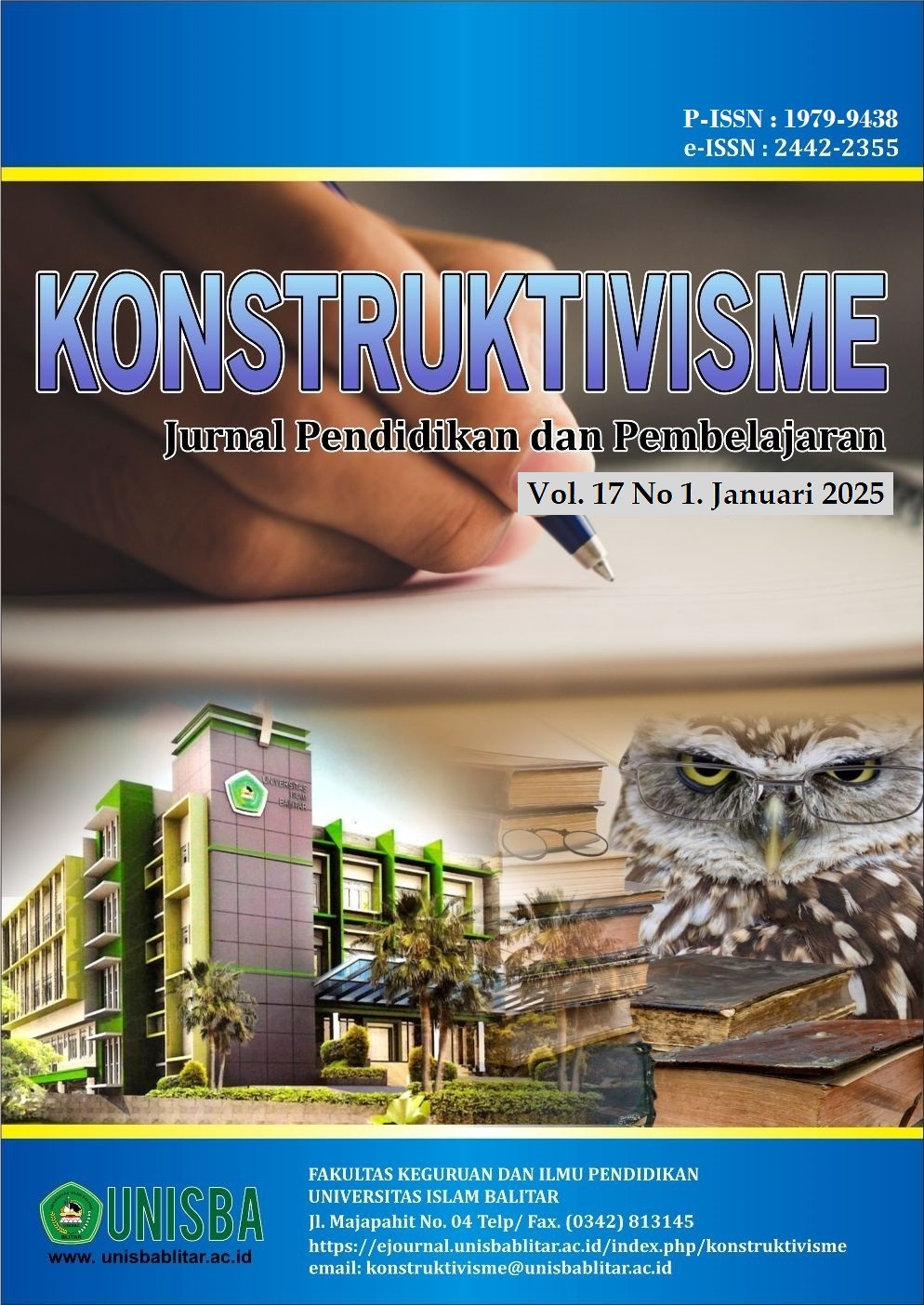Pengaruh Media Pembelajaran Digital (Chem Office Ultra) terhadap Pemahaman Konseptual Mahasiswa pada Materi Struktur Molekul
DOI:
https://doi.org/10.35457/konstruk.v17i1.4086Keywords:
Kognitif; Eksperimen; SampelAbstract
Penelitian ini bertujuan untuk menguji pengaruh media pembelajaran digital (chem office ultra) terhadap pemahaman konseptual mahasiswa pada materi struktur molekul. Penelitian ini menggunakan desain pra-eksperimental dengan penelitian pre-test dan post-test one group design. Penelitian ini dilakukan pada satu kelas eksperimen tanpa menggunakan kelas kontrol. Instrumen yang digunakan adalah tes kognitif pada materi struktur molekul untuk menilai pemahaman konseptual mahasiswa. Sampel yang digunakan dalam penelitian ini adalah mahasiswa tahun pertama Program Studi Pendidikan Biologi Universitas Nahdlatul Wathan Mataram Tahun Ajaran 2024/2025. Hasil uji hipotesis dengan nilai signifikansi thitung < 0,05 dan nilai R-Square sebesar 62%. Hal ini menunjukkan bahwa media pembelajaran digital memiliki pengaruh cukup signifikan terhadap pemahaman konsep mahasiswa pada materi struktur molekul.
Downloads
References
H. R. Widarti, D. Triwidiastuti, and D. A. Rokhim, “Profile of Interactive Learning Media Based Digital Literacy Needs on Elemental Chemistry Concepts,” JTK (Jurnal Tadris Kim., vol. 7, no. 2, pp. 277–286, Dec. 2022, doi: 10.15575/jtk.v7i2.20921.
N. Hidayat and S. Suryadi, “Improving Student Learning Outcomes Through The Use Of Digital Learning Media,” J. Visi Ilmu Pendidik., vol. 15, no. 1, p. 29, Jan. 2023, doi: 10.26418/jvip.v15i1.54889.
Erlina, D. P. Williams, C. Cane, Hairida, M. Ulfah, and A. F. Wafiq, “Reconstructing perspectives: investigating how molecular geometry cards (MGCards) and molecular model building (MMB) disrupt students’ alternative notions of molecular structure – a qualitative study,” Chem. Educ. Res. Pract., vol. 25, no. 4, pp. 1052–1070, 2024, doi: 10.1039/D3RP00038A.
Michelle Firsta Karima Sara, Ambiyar, Dedy Irfan, and Hasan Maksum, “Development of Moodle-Based E-Learning Media in Workshop and Entrepreneurship Learning,” JTP - J. Teknol. Pendidik., vol. 26, no. 2, pp. 689–699, Aug. 2024, doi: 10.21009/jtp.v26i2.47877.
S. J. H. Yang and C. S. J. Huang, “Taiwan Digital Learning Initiative and Big Data Analytics in Education Cloud,” in 2016 5th IIAI International Congress on Advanced Applied Informatics (IIAI-AAI), Jul. 2016, pp. 366–370. doi: 10.1109/IIAI-AAI.2016.41.
N. Nana, “Penerapan Eksperimen Virtual Phet Terhadap Model Pembelajaran Poe2we Pada Tumbukan Untuk Melatih Keterampilan Proses Sains,” J. Inov. dan Pembelajaran Fis., vol. 7, no. 1, pp. 17–27, Apr. 2020, doi: 10.36706/jipf.v7i1.10912.
A. Puji, K., Gulӧ, F., & Ibrahim, “Pengembangan Multimedia Interaktif Untuk Pembelajaran Bentuk Molekul di SMA,” J. Penelit. Pendidik. Kim. Kaji. Has. Penelit. Pendidik. Kim., vol. 1, no. 1, pp. 59–65, 2014, doi: https://doi.org/10.36706/jppk.v1i1.2385.
Isra Miharti and Epinur, “Pengembangan Media Interaktif Berbasis Komputational Pada Materi Bentuk Molekul,” J. Res. Educ. Chem., vol. 6, no. 1, p. 49, May 2024, doi: 10.25299/jrec.2024.vol6(1).17558.
M. C. Rezende and C. A. Vidal, “Enhancing Science Education Through Visual Chemistry,” Scientia, 2021, doi: 10.33548/SCIENTIA692.
N. Fadilah, “The Impact of Visual Media on Enhancing Students’ Comprehension of Islamic Religious Education Lessons,” WARAQAT J. Ilmu-Ilmu Keislam., vol. 8, no. 2, pp. 203–210, Dec. 2023, doi: 10.51590/waraqat.v8i2.576.
E. M. Pakpahan, “Exploring Pre-Service Teachers’ Perspectives On The Use Of Digital Learning Media,” J. Smart, vol. 10, no. 1, pp. 96–104, Feb. 2024, doi: 10.52657/js.v10i1.2291.
D. Mayarisa, “Analytical Study on the Urgency of Media Learning in Islamic Religious Education,” Int. J. Educ. Comput. Stud., vol. 3, no. 3, pp. 76–80, Nov. 2023, doi: 10.35870/ijecs.v3i3.1805.
S. N. L. Hikmah, P. Saadi, and A. Sholahuddin, “Sway-Based Interactive Chemistry Learning Media: Feasibility for Improving Students’ Conceptual Understanding and Self-efficacy,” J. Penelit. Pendidik. IPA, vol. 9, no. 3, pp. 1076–1084, Mar. 2023, doi: 10.29303/jppipa.v9i3.1698.
Hamdani Hamdani, Abdul Rahman, and Haidah Haidah, “Improving Student Accessibility and Engagement with Applications as Learning Media in the Digital Era,” J. Int. Multidiscip. Res., vol. 2, no. 10, pp. 24–28, Oct. 2024, doi: 10.62504/jimr910.
I. N. Sani and R. Arianingrum, “The Effect of STAD-Cooperative Learning Model with Concept Maps in Promoting Students’ Self-Efficacy and Conceptual Understanding of Thermochemistry,” J. Pendidik. Kim. Indones., vol. 8, no. 2, pp. 75–86, Nov. 2024, doi: 10.23887/jpki.v8i2.76461.
Sugiyono, Metodologi Penelitian Kuantitatif dan Kualitatif dan R&D. Bandung: Alfabeta, 2019.
B. Tamilarasi, P. Kanagavalli, and Y. Jayasleen, “Drug non compliance among hypertensive patients.,” J. Nurs. Trendz, vol. 10, no. 2, p. 27, 2019, doi: 10.5958/2249-3190.2019.00016.6.
W. C. Hair Jr., J. F., Anderson, R. E., Babin, B. J., & Black, “Multivariate Data Analysis,” 5th ed., New Jersey: PrenticeHall, Inc, 2011, pp. 611–628.
R. A. Ardhani, S. Setiyanto, and I. Permatahati, “Augmented Reality 3D Heart as Learning Media at Midwifery Lab University of ’Aisyiyah Surakarta,” Int. J. Comput. Inf. Syst., vol. 3, no. 1, pp. 1–5, Jan. 2022, doi: 10.29040/ijcis.v3i1.53.
E. A. Siregar and Y. Kurniawati, “The Analysis of Students’ Mental Models Using Macromedia Flash-Based Learning Media on Molecular Shapes Lesson,” J. Inov. Pendidik. Kim., vol. 16, no. 1, pp. 47–52, Jan. 2022, doi: 10.15294/jipk.v16i1.29869.
D. F. Thieker, J. Hadden, J. Stone, and R. Woods, “Introducing Glycans to Molecular Visualization Software,” FASEB J., vol. 30, no. S1, Apr. 2016, doi: 10.1096/fasebj.30.1_supplement.1097.1.
R. Pratiwi, E. Suistyaningsih, and K. Septianzah, “Aplikasi Chem Draw Sebagai Media Inovasi Guru Dalam Pengajaran IPA Terpadu,” Bioedusiana, vol. 4, no. 2, pp. 38–43, 2019, doi: 10.34289/285228.
Downloads
Published
Issue
Section
License
Authors who publish with this journal agree to the following terms:
- Authors retain copyright and grant the journal right of first publication with the work simultaneously licensed under a Creative Commons Attribution License that allows others to share the work with an acknowledgement of the work's authorship and initial publication in this journal.
- Authors are able to enter into separate, additional contractual arrangements for the non-exclusive distribution of the journal's published version of the work (e.g., post it to an institutional repository or publish it in a book), with an acknowledgement of its initial publication in this journal.
- Authors are permitted and encouraged to post their work online (e.g., in institutional repositories or on their website) prior to and during the submission process, as it can lead to productive exchanges, as well as earlier and greater citation of published work (See The Effect of Open Access).
Deprecated: json_decode(): Passing null to parameter #1 ($json) of type string is deprecated in /home/ejournal.unisbablitar.ac.id/public_html/plugins/generic/citations/CitationsPlugin.php on line 68












